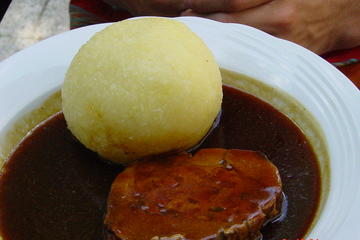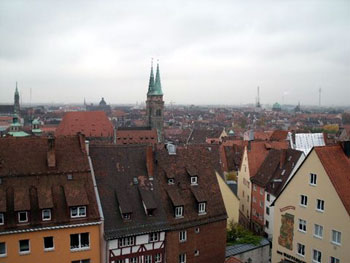
by Roy A. Barnes
Before visiting Nuremberg, Germany I associated the city with just two things: The Third Reich, where those shameful, yet eerily hypnotic rallies were held to glorify Hitler and also for the war criminals trials after World War II. Yet Nuremberg is much more than that. This city of half a million people (and a 3.5 million metropolitan area population) might really overwhelm you the first time you venture into it. But because many of the city’s major attractions are within its old city walls and because of its very user-friendly and extensive public transport system of trams, subways, and buses, Nuremberg soon becomes small town manageable. This makes it easier to enjoy its numerous museums and its storied history around every turn of the corner.
Ironically, for such a big city, one of its claims to fame is the smallest sausages in Germany that weigh less than an ounce. They’re called Nurembergers. I savored their nicely-smoked taste inside the city’s old walls around its Hauptmarkt in a busy sausage house called Bratwursthausle. It’s frequented by locals and tourists alike, where the owner visits the tables and dispels his special brand of “Christmas cheer” on a daily basis.
Christmas Shopping Year Round For All Budgets, Even For The Late Michael Jackson!
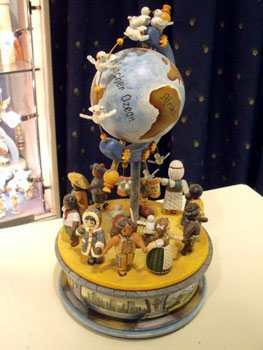 How did the largest chain of stores in the world selling traditional German Christmas items come to fruition? You can thank the military police as the reason. Circa 1963, IBM worker Wilhelm Wohlfahrt went door to door around the military installation in Boblingen trying to sell some music boxes made in Erzgebirge (in Saxony). He had only wanted to buy one originally for his friends, but was forced to buy a lot of ten from a wholesaler, so he wanted to unload the rest to recoup his money. He was found out and foiled by the military police since this activity was illegal. They suggested to him that he sell them at weekend craft shows on base instead, and the rest is history.
How did the largest chain of stores in the world selling traditional German Christmas items come to fruition? You can thank the military police as the reason. Circa 1963, IBM worker Wilhelm Wohlfahrt went door to door around the military installation in Boblingen trying to sell some music boxes made in Erzgebirge (in Saxony). He had only wanted to buy one originally for his friends, but was forced to buy a lot of ten from a wholesaler, so he wanted to unload the rest to recoup his money. He was found out and foiled by the military police since this activity was illegal. They suggested to him that he sell them at weekend craft shows on base instead, and the rest is history.
Within the city walls of Nuremberg is the charming and intimate retail outlet of Kathe Wohlfahrt named after Wilhelm’s wife, where every day is like Christmas, except for the music selections. They wait until December 1 to start playing Christmas music. I browsed the various Christmas decorative items like ornaments, rauchermanner/mannchen (smoking men which puff out incense), nutcrackers, and music boxes that are priced for all budgets, including that of the late Michael Jackson’s. In 2003, he bought a music box called “Children of the World”, which is still available today for customers willing to pay about $2,500 to say they have something the “King of Pop” got enjoyment from.
Dolls Galore at the Spielzeugmuseum!
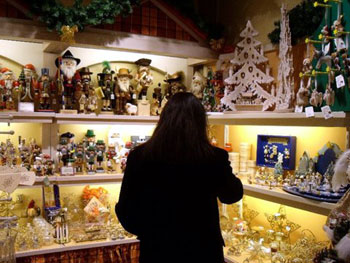 Nuremberg is known for its dockenmacher (dollmakers) dating back to medieval times. Because a nice dollhouse is often on the Christmas wish list of many children. I found the most comprehensive collection of doll houses, dolls, and doll house fixtures at the Spielzeugmusuem. It will astonish you. The older the dolls and their related items, the more detailed they seemed to be. It’s amazing just how much effort the past generations have put into creating such detailed toys, an art that seems to have been generally lost because of the hyper-technological age we live in today. But this is just the tip of the iceberg of what toys you’ll see there, toys that brought back a lot of childhood memories for me.
Nuremberg is known for its dockenmacher (dollmakers) dating back to medieval times. Because a nice dollhouse is often on the Christmas wish list of many children. I found the most comprehensive collection of doll houses, dolls, and doll house fixtures at the Spielzeugmusuem. It will astonish you. The older the dolls and their related items, the more detailed they seemed to be. It’s amazing just how much effort the past generations have put into creating such detailed toys, an art that seems to have been generally lost because of the hyper-technological age we live in today. But this is just the tip of the iceberg of what toys you’ll see there, toys that brought back a lot of childhood memories for me.
The exhibits go back to the early 1800’s through the present day, covering four floors. They include tin soldiers, view finders, puppets, trains, animals, and rocking horses. I was especially impressed with its collection of Seiffen matchbox miniatures from the early 1900s. I was awed by the tin American toys from the previous century like those of Dick Tracy and Walt Disney. I noticed that visitors could go up to the fourth floor via a spiraling staircase, which I took and found even more of a child’s fantasy land full of interactive exhibits to help keep them occupied while the adults reminisce about their childhood.
Lest We Forget the Gingerbread
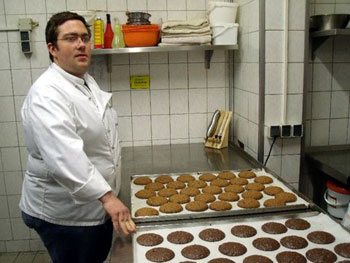 Nuremberg gingerbread (known as lebkuchen) is considered some of the best in the world. Lebkuchen has its roots via the Franconian monks who created honey cakes (pfefferkuchen), of which the sweet nectar was procured from the local bee colonies since it was cheaper to use than imported Asian sugar. But the lebkuchen that we know today goes back around six centuries to 1395, though the first city gingerbread guild didn’t come out until 1643. A law was made requiring sellers to own their own oven and a number of bakers became masters by marrying the daughter of a master baker.
Nuremberg gingerbread (known as lebkuchen) is considered some of the best in the world. Lebkuchen has its roots via the Franconian monks who created honey cakes (pfefferkuchen), of which the sweet nectar was procured from the local bee colonies since it was cheaper to use than imported Asian sugar. But the lebkuchen that we know today goes back around six centuries to 1395, though the first city gingerbread guild didn’t come out until 1643. A law was made requiring sellers to own their own oven and a number of bakers became masters by marrying the daughter of a master baker.
I visited a local family-run bakery Confiserie Café Neef to see the making of top knotch lebkuchen, known as “Elisen”, named after a baker’s daughter. I was able to savor some freshly-baked product. The mid-afternoon traffic inside was constant as patrons sat with liquid refreshments enjoying a variety of hand-created pastries and chocolate Santas with red and white suits. These works of art were almost too beautiful to eat!
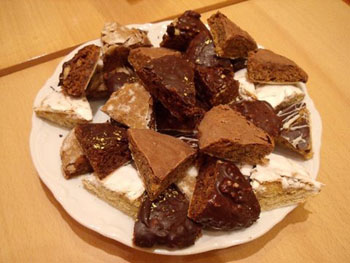 The Neefs use such ingredients like ginger, nutmeg, cinnamon, hazelnuts, vanilla, cloves, honey, lemon peel and orange peel for their base recipe that’s over 500 years old, though they offer 8 kinds during the fall and winter (including one with chocolate). The bakery uses machinery that can produce 2500 mound-like lebkuchen in an hour (compared to individual hand molds that a skilled baker would take 5 hours to shape that same amount by scraping the batter like a brick layer does mortar for bricklaying). I was able to sample some of the raw dough that was dominated by the flavor of orange. It takes 15 minutes at 356 degrees Fahrenheit (180 degrees Centigrade) to bake the lebkuchen, and upon coming out of the oven, it’s a must try, even if you’re on a diet! What I like about the finished goodies is the lightly fruity flavor that’s got a chewy feel to it. The ones with chocolate were especially good.
The Neefs use such ingredients like ginger, nutmeg, cinnamon, hazelnuts, vanilla, cloves, honey, lemon peel and orange peel for their base recipe that’s over 500 years old, though they offer 8 kinds during the fall and winter (including one with chocolate). The bakery uses machinery that can produce 2500 mound-like lebkuchen in an hour (compared to individual hand molds that a skilled baker would take 5 hours to shape that same amount by scraping the batter like a brick layer does mortar for bricklaying). I was able to sample some of the raw dough that was dominated by the flavor of orange. It takes 15 minutes at 356 degrees Fahrenheit (180 degrees Centigrade) to bake the lebkuchen, and upon coming out of the oven, it’s a must try, even if you’re on a diet! What I like about the finished goodies is the lightly fruity flavor that’s got a chewy feel to it. The ones with chocolate were especially good.
If You Go:
Bratwursthausle: Rathausplatz 1, 90403 Nuremberg. Phone: +49 (0911) 227695. Website: www.bratwursthaeusle.de
Kathe Wohlfahrt: Königstrasse 8, 90402 Nuremberg, Phone: + 49 (0) 9861-4090. Website: www.bestofchristmas.com
Spielzeugmusuem: Karlstrasse 13-15, 90403 Nuremberg, Germany. Phone: +49 0911-231-3164. Website: www.museums.nuremberg.de/toy-museum
Confiserie Café Neef: Winklerstrasse 29, 90403 Nuremberg, Germany. Phone: +49 (0911) 22 51 79. Website: www.confiserie-neef.de
I stayed that Sheraton Carlton Nuremberg, which is just a block away from the old city that contains the Christmas-themed attractions. The beds are quite comfortable and you get a good amount of workspace. There are speakers in the bathroom so you can hear the television, important if you’re really into a ballgame or some other program. Located at Eilgutstrasse 15, D-90443, Nuremberg. Phone: +49-911-2003-0 . Website: www.starwoodhotels.com
Nuremberg Tourist Information: www.nuremberg.de
About the author:
Roy A. Barnes writes from southeastern Wyoming and is a frequent contributor to Travel Thru History. Mr. Barnes attended the German National Tourist Office’s “The Making of Christmas” press trip in 2009, in which he got to experience the things discussed in this article. He freely wrote his impressions without any editorial scrutiny from the sponsor.
All photos are by Roy Barnes.

